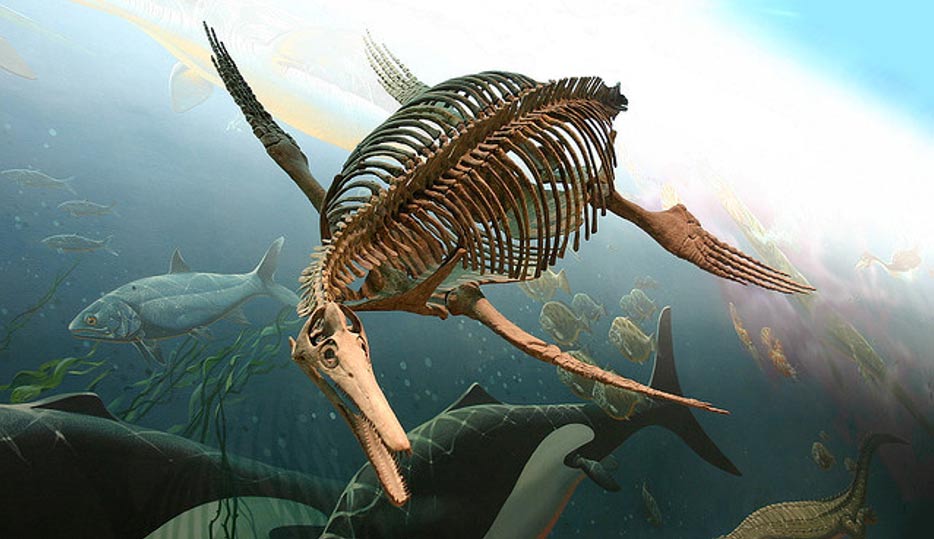
The fossilized skeletons of strange creatures—odd, beaked fish with teeth and ‘feet’—were uncovered by quarry workers in southwestern England in the early 1800’s. Dubbed “fish lizards” (or Ichthyosauria) at the time, the old discoveries are now under new examination. These ancient sea monsters, specimens collected from across Europe, are apparently not one animal type, but many different unique species.
Resembling a cross between fish and dolphins, ichthyosaurs dominated the world’s oceans from 250 million years ago to about 90 million years ago. In similar evolutionary circumstances to modern whales and dolphins, it’s thought the ancestors of ichthyosaurs were land reptiles that returned to the sea. They thrived until they became extinct during the Late Cretaceous for reasons unknown. They lived worldwide, with the largest known colony found near Oxford; Britain, which was once warm, shallow sea.

All shapes and sizes: Illustration showing the diversity of various Ichthyosaurs. (CC BY 3.0)
At the small village of Street, UK, hundreds of such skeletons were found embedded in the quarry rocks.
According to LiveScience, there was a thriving interest in fossils at the time, especially for large reptiles, and any such finds generated much publicity. “There were some rich gentry in the area who would buy them from quarrymen, prepare them and put them in these big wooden frames,” said Judy Massare, a professor of geology at SUNY College at Brockport in New York, and co-author of a study published in the Journal of Vertebrate Paleontology on ichthyosaurs in West Dorset, England.
As the science of fossils was still in its infancy in the 19 th century, any skeletal remains that resembled the ichthyosaurus were difficult to order (so resembling fish, newts, crocodiles and the platypus) and thus were lumped into one category, Ichthyosauria, or even Ichthyopterygia, “fish flippers”.
Dean Lomax, paleontologist at the University of Manchester stumbled over a 189-million-year-old fossil in the Doncaster Museum and Art Gallery in the UK in 2008, which he identified as a new species of ichthyosaur, reports Phys.org.

Ichthyosaur of an undetermined genus. 1916. (Public Domain)
Lomax and Massare examined the new species, the first to be identified in 130 years, and named it Ichthyosaurus anningae, after Mary Anning (1799 – 1847) British fossil collector and paleontologist well known for her important finds of Jurassic marine fossils. As a woman working in the sciences in the 19 th century, she did not receive credit for many of her discoveries.

Portrait of Mary Anning, English fossil collector and paleontologist. (Public Domain)
This surprise prompted the researches to examine other collections to see if there might be many other unidentified or misidentified species of ichthyosaur.
They found that throughout museum collections (which may have come from early private collectors) many specimens were mislabeled, and some groupings may have reflected three or four different species under one heading. In addition, at least one of the skeletons might belong to another newly identified species, but more research is required to confirm this.
Massare told LiveScience, “What we’re finding is, one species that we used to think was extremely variable only looks variable because we were combining a couple of other species. We’re now trying to figure out the boundaries between those different species.”

Several Ichthyosauria in the Natural History Museum of London. Human visitors show the scale of the various beasts – both great and small. (Drow male/CC BY-SA)
Variances in teeth, length, and fin shape suggest to researchers that various animals swam differently than others, and hunted different prey.
It would seem that the species Ichthyosaurus communis found in Street, UK is not as common as previously believed. The researchers note that since the recognition of the Ichthyosaurus anningae “at least seven species of Ichthyosaurus are found in the Lower Jurassic strata [rock layer] of the United Kingdom, making it the most diverse ichthyosaurian genus of that time interval.”

Earlier species looked more like eels, and later species more like modern dolphins. CGI restoration of Ichthyosaurus communis , Early Jurassic of England. (CC BY 3.0)
Continuing research will undoubtedly reveal the widespread diversity of prehistoric marine life, and contribute to the body of knowledge surrounding the strange and interesting “fish lizards”.
Study findings were presented last month at the Society of Vertebrate Paleontology conference in Texas.